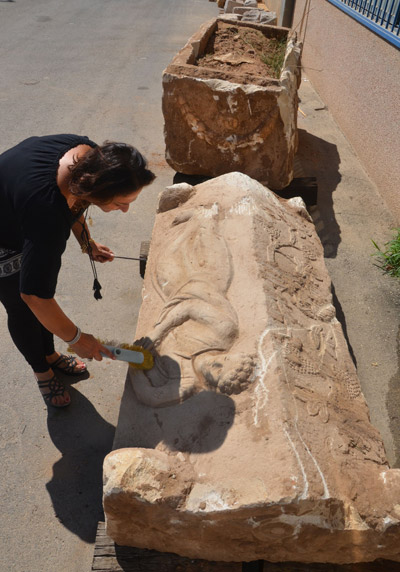(
Israel Antiquities Authority)
A unique and extremely impressive stone sarcophagus, about 1,800 years old, was exposed at a building site in the new neighborhood of villas currently going up in Ashkelon. This occurred during an operation carried out on Tuesday night (September 1) by inspectors of the IAA's Unit for the Prevention of Antiquities Robbery and patrol officers and detectives from the Ashkelon police station.
This is one of the rarest sarcophagi ever discovered in Israel. The coffin, which is made of hard limestone, weighing about 2 tons and 2.5 meters long, is sculpted on all sides. A life-size figure of a person is carved on the sarcophagus' lid. The sarcophagus was repeatedly struck by a tractor in different places, scarring the stone and damaging the decorations sculpted by an artist on its sides.
Dr. Gabi Mazor, a retired IAA archaeologist and an expert on classical periods, described the scene on the sarcophagus: "One side of the sarcophagus lid is adorned with the carved image of a man leaning on his left arm. He is wearing a short-sleeved shirt decorated with embroidery on the front. A tunic is wrapped around his waist. The figure's eyes were apparently inlaid with precious stones that have disappeared and the hair is arranged in curls, in a typical Roman hairstyle. On the other side of the lid is a carved relief of a metal amphora (a vessel used for transporting liquids such as wine) from which there are intertwining tendrils bearing grape clusters and grape leaves.
The sarcophagus itself, which was more severely damaged by the tractor, is decorated with, among other things, wreaths and images of bulls' heads, naked Cupids, and the head of the monstrous female figure Medusa which includes remains of hair together with snakes, part of a commonly held belief in the Roman period that she protects the deceased." According to Mazor, "Such sarcophagi were usually placed in or next to a family mausoleum. The high level of decoration attested to the family's affluence, which judging by the depicted motifs was probably not Jewish."

The sarcophagus and lid during the initial cleaningCopyright: Yoli Shwartz, courtesy Israel Antiquities Authority The irreparable damage was caused by contractors who encountered the impressive sarcophagus during the course of their work. They decided to hide it, pulled it out of the ground with a tractor causing considerable damage, concealed it beneath a stack of sheet metal and boards, and poured a concrete floor in the lot so as to conceal any evidence of the existence of the antiquities site.
Information received by the IAA's Unit for the Prevention of Antiquities Robbery about unlawful activities at the construction site led to a nighttime search in the area. A close examination of the area revealed the concealed sarcophagus and lid. During the questioning of the laborers at the Ashkelon police station, it became clear that the sarcophagus was excavated last week. Two building contractors were detained on suspicion of not reporting an ancient discovery and damaging an antiquities site - an offense punishable by five years imprisonment.
Amir Ganor, head of the Inspection Department at the Israel Antiquities Authority said, "This is an extremely serious case of damage to a rare antiquity of unprecedented artistic, historical and cultural importance. The IAA is attentive to the development needs and the needs of the public, but will strictly enforce the law against those who knowingly damage antiquities, which are assets belonging to us all. Out of consideration for the owners of the lots, we permitted building in the new neighborhood of villas, on condition they would report any discovery of antiquities in the area right away and immediately halt work until the arrival of our representative. In this case, the building contractors chose to hide the rare artifact and their action has caused painful damage to history. Legal proceedings will now be taken against those involved."